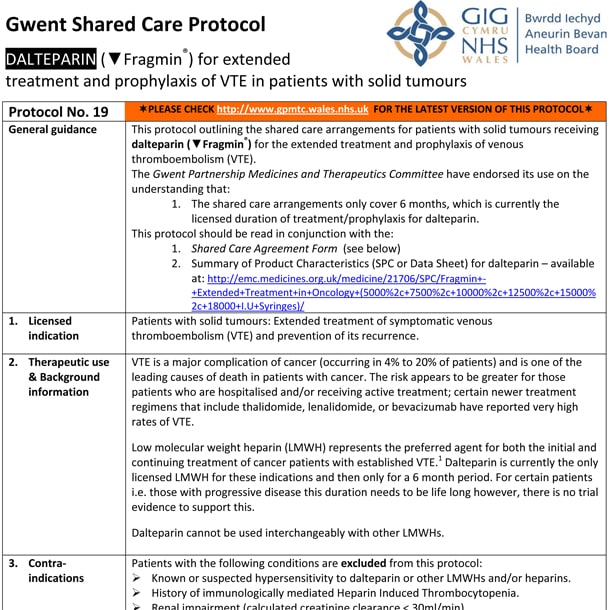Summary
In response to several examples of sub-optimal patient care, safety and patient experience in the management of venous thromboembolism in cancer patients, the team developed a dedicated cancer-associated thrombosis service.
The service, which comprises a multi-professional team, was developed through collaborative working across three clinical organisations and serves patients from seven district general hospitals. Key achievements so far include the development of consistent and safe practice in the management of cancer-associated thrombosis and the creation of formal shared care agreements between secondary and primary care for the safe prescribing of low molecular weight heparin.
Challenge
Clinical incidents and poor patient experiences suggested that improvements were needed in how cancer associated thrombosis CAT was managed in South East Wales. A six month-long audit of CAT cases identified three areas of concern: the reluctance of primary care to prescribe LMWH; hospital admissions and increased bed stays arising from sub-optimal CAT management; and inconsistent practice across oncology in the management of CAT.
The inconsistent practice referred to a number of problem areas, including choice of drug, length of anticoagulaton and the monitoring of platelet count.
Two qualitative studies identified several issues which suggested the patient experience of CAT management was sub-optimal. Problems included insufficent support at diagnosis and unclear referral pathways.
Objectives
The overall objective of the project were to develop a state-of-the-art cancer CAT service. Specific objectives were to improve local LMWH access for patients with CAT, to provide them with better access to information and support, and to ensure consistent referral pathways and practice in the management of CAT. The project also aimed to enable patients to participate in relevant clinical trials, and to develop an integrated service with relevant clincal stakeholders.
Solution
A multiprofessional clinical steering committee was established to identify challenges to optimal care, with particular emphasis on developing practical solutions. The team developed a shared care protocol and secured local agreements with the primary care services of Cardiff and the Vale University Health Board (CAVUHB) and Aneurin Bevan University Health Board (ABUHB).
CAT-specific patient information leaflets were developed, and given to patients at disgnosis (though pharmacies). The supportive role of district nurses in training injection technique and offering suppport/information was optimised.
A pathway was established so that all new patients are referred to the CAT clinic at point of VTE diagnosis, and seen within four weeks, and dedicated trial nurses have been made available for recruitment to portfolio-badged studies.
Results
This service has primarily affected cancer patients with DVT and PE. Support has also been given to chemotherapy patients with atrial fibrillation and artficial heart valves. The uptake of shared care protocol is currently 98 per cent in ABUHB and 90 per cent in CAVUHB.
The new leaflets have received favourable feedback, while the CAT clinic and district nursing services have a closer working relationship.
Evaluation of the CAT clinic has shown that patients find it supportive and informative, reducing their anxiety over VTE. Funding has been sought for a formal evaluation by referring clinicans. Informal feedback has been excellent.
Fifty-two patients have participated in portfolio trials, both specific to CAT-specific. Funds generated by recruitment will provide further trials support.
The integrated service has optimised management of CAT patients embarking on surgery though agreed bridging protocols. The CAT service is alerted when patients are admitted to hospital.
Learnings
The team behind the project learned that it is essential to understand the committees and processes to adher to in order to effect change. They also learned that change can more easily be effected if each stakeholder sees a benefit for themselves.
Another important lesson was the importance of providing a service which patients see as helpful. Through undertaking a formal patient evaluation of the service, the team was able to adapt its processes according to patients’ needs.
The success of this project lay in its partnership with patients.
Evaluation
Following the introduction of the I-CAT project, the service was evaulated through the Patient Experience of LIving with CANcer Associated Thrombosis (PELICAN) study. Results show a number of benefits, including: easy access to information; readily available support and education with self injecting; and psychological support during the cancer journey. Good communication between services (oncology, surgery and primary care) and ease of access to medicines were also highlighted.
Since the introduction of I-CAT, there have been no reported clinical incidents or complaints about CAT management.
In I-CAT’s first year, 280 new CAT cases have been seen, with additional referrals for the management of six patients with artificial valves and 40 referrals of old CAT patients needing length of anticoagulation reviewed.





